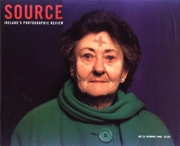Everywhere And Nowhere
'Common Sense' by Martin Parr was at the Gallery of Photography, April, 1999
Review by Fintan O'Toole
Issue 19 Summer 1999
View Contents ▸
For most of his career, one of the strongest strains in Martin Parr's work has been a sense of place. His images have always been witty, often comic and sometimes surreal. But they have unfolded within a very clear documentary framework. His large-scale projects were shaped by the need to document a place and a community. His images of the West of Ireland (in A Fair Day) or of a dilapidated English seaside resort (The Last Resort) were certainly not naive or sentimental, but they were imbued with a deep particularity. They capture a place and a time, a society caught in a moment of transition.
In retrospect, it can be seen that such images were shaped by a feeling that always comes with the best documentary: a sense of elegy, an acute awareness that the world they depict is on its way out. The wit and humour of Parr's pictures sprang to a large extent from his eye for incongruity. He could always see the bits of another world that were floating into the landscape he photographed. In the West of Ireland he could see the American-style burger bars behind the apparently timeless horse-traders at a fair in Mayo. On the English coast, he could spot the decay surrounding the garish jollity of the working-class holiday-makers.
Now, in his superb new show about tourism, Common Sense, the sense of place has been fully replaced by a sense of placelessness. Most of the images are deliberately presented out of context. We move close up to a hand holding an ice-cream or a cocktail, a pair of feet in pink socks and open-toed sandals, the back of a neck, some pieces of raw fish, a toilet door, the face of a blow-up doll in a box. There is never a full portrait of a person. There is almost never a clear external background which will tell us where the shot was taken. We can gather from internal evidence - stickers, labels, the money that people are holding - that some of the photographs are from Disneyland in Paris and others from Disney World in Florida, some from Ireland and others from Japan, some from London and others from Spain. But these clues are so random and so mute that they tend not to reduce the feeling of being everywhere and nowhere but to underline it.
And not only do the images not have a clear external context, but they also refuse to create an enclosed internal context either. Rather than stand alone, so that the viewer can get lost in their formal complexity and technical virtuosity, they create surreal juxtapositions. In a general sense they function as a whole, so that the totality of the exhibition is much more powerful than the sum of the individual images. But in particular they operate in pairs. Each picture has a surreal twin with which it forms an uncanny, funny and disconcerting double-act.
Sometimes the connection is obvious to the point of being almost pat. A picture of gold bars set against a picture of what seem to be heart-shaped sweets wrapped in gold foil seems to be contrasting the real and the ersatz. Many of the pairs consist of one human or natural image and one inanimate, inorganic object, and it might be supposed that the same kind of contrast is implied. The oiled and sun-burned chest of a tourist set beside three slabs of raw meat on hooks seems to depend on a mildly amusing but rather conventional thought.
In fact, though, the real connections are, to an overwhelming extent, purely visual. The broad pattern of shapes and colours in one image is echoed in the other. But the objects depicted are wildly different. A multicoloured breakfast on a tray has its counterpart in a baseball cap made of brightly coloured buttons. The locks of black hair hanging over a mans forehead transmutes into the black cables hanging in front of a fleshy porno poster in what is presumably a garage or electrical repair shop. A bar code sticker on a marbled floor mirrors the pattern on a man's cardigan. A row of penis-shaped virbrators sits next to a tray of similarly vertical and flesh-coloured raw fish. The top of a tomato becomes the open red mouth of a blow-up doll.
The effect is at once hilarious and dizzying. There is, on the one hand a classically comic view of the world in which everything is connected and the most unlikely things meet in happy coincidence. And on the other a whirling nightmare in which everything loses definition and shifts its nature. We get a kind of Dada documentary, at once real and surreal. Or rather, for the show is a brilliantly accurate portrayal of a world in which the difference between natives and tourists has collapsed, a stunning evocation of the surreal reality of the late 20th century.
Other articles by Fintan O'Toole:
Other articles mentioning Martin Parr:
Other articles on photography from the 'Documentary' category ▸






